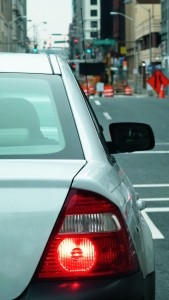Car manufacturers have apparently given up on trying to battle driver distraction while the vehicle is in motion. Recently, a number of them have unveiled technologies that are intended to make it easier for drivers to stay connected and communicating while behind the wheel. 
These include so-called “heads-up” technologies that require the driver to look up at a hovering hologram on their windshield in order to engage the communication system, which can include voice and video calls, social media messages and e-mails.
The idea is driver will have to at least keep their eyes in the general direction of the road, rather than looking down. Manufacturers reason this will reduce crashes because drivers will have their eyes up ahead.
Our Boston traffic accident attorneys know this thinking is flawed and problematic. It assumes that just because someone’s head is turned in a general direction that he or she is paying attention to what they are looking at.
Researchers with the National Safety Council have studied this issue extensively. They concluded effective multitasking is a myth because the human brain simply can’t divide its attention among higher-level thinking functions. Talking and driving are both considered higher-level thinking functions. That’s why drivers aren’t any safer on a hands-free cell phone than on a hand-held device; because ultimately, they are still engaged in two thinking tasks at once.
In the same way, drivers might be looking at the windshield and not actually seeing what’s on the road in front of them.
The Washington Post in an article detailing the new technology referred to the front car windshield as the “once-sacred place of clarity.”
Now, reports are it will be cluttered with images informing drivers of speed and navigation, as well as cell phone notifications, text messages and social media alerts.
Those behind the technology – which include the auto manufacturers, as well as a number of technology start-up firms, insist these displays are going to make us all safer by preventing drivers from fumbling with their smartphones and navigation systems.
But safety advocates counter these devices simply create even more ways to steal driver’s attention from what should be their sole focus behind the wheel: Driving.
Carrying out that task safely requires full focus, and creating systems that make it easier for drivers to engage in numerous tasks at once will only serve to further the erroneous notion that these activities are somehow safe.
Auto manufacturers are competing for increasingly tech-savvy buyers, and all are trying to one-up each other. Safety advocates note that makers of these “heads-up” features have backed their assertions of safety with any scientific showing. They only insist if you’re looking straight ahead, than it’s safe. But study after study has shown that isn’t so.
Select models of BMW, Volvo and Hyundai are offering these features in new model vehicles. But as the technology becomes less expensive, we are likely to see it standard in most vehicles, even lower-end models.
Some warn of pedestrians and bicyclists, while others suggest points of interest. One even displays a so-called “ghost car” that motorists could follow as an alternative to standard navigation directions read aloud.
If you have been injured in a car accident in Boston, contact our offices today.
Call Jeffrey Glassman Injury Lawyers for a free and confidential appointment — (617) 777-7777.
Additional Resources:
Windshield Devices Bring Distracted Driving Debate to Eye Level, May 29, 2015, By Matt Richtel, The New York Times
More Blog Entries:
100 Deadliest Days for Teen Drivers in Massachusetts Underway, May 29, 2015, Boston Auto Accident Attorney Blog
 Boston Car Accident Lawyer Blog
Boston Car Accident Lawyer Blog

